 |
 |
 |
http://www.varalaaru.com A Monthly Web Magazine for South Asian History [187 Issues] [1839 Articles] |
 |
 |
 |
http://www.varalaaru.com A Monthly Web Magazine for South Asian History [187 Issues] [1839 Articles] |
|
Issue No. 172
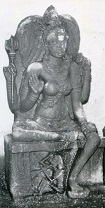
இதழ் 172 [ அக்டோபர் 2023 ] 
இந்த இதழில்.. In this Issue.. 
|
Author: www.glorioustamils.com; www.attraithingal.com Damarugam 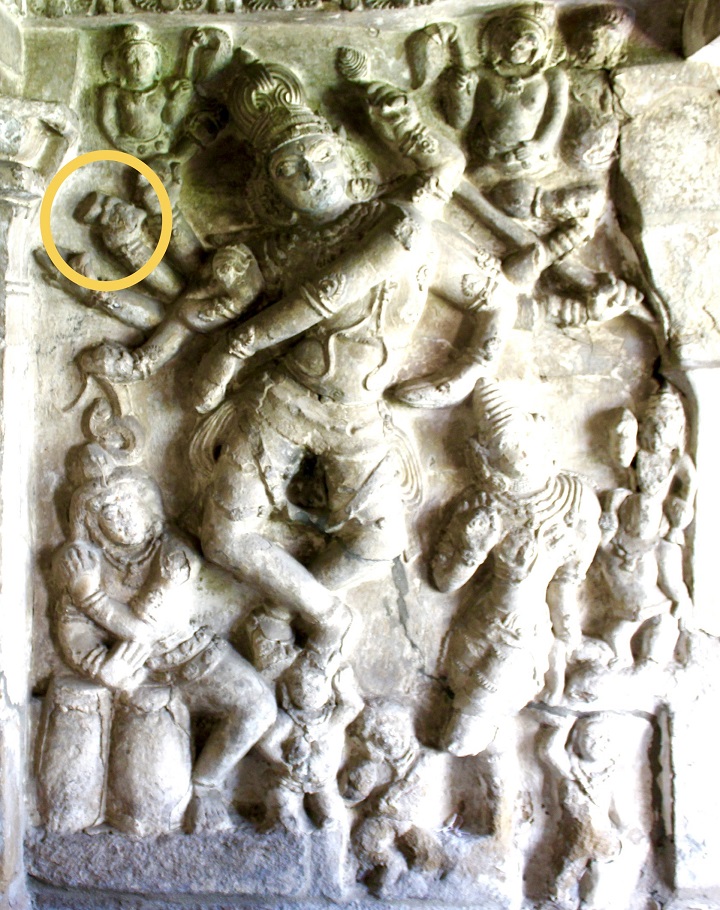 damarugam in the right hand of dancing shiva, muktheeswaram, kanchipuram (pallava period) Damarugam is introduced by Karaikkal Ammaiyar in her Mootha Thiruppathigam, as an exclusive instrument played by Shiva while he dances in the graveyard, along with several other attributes like the crescent moon, river Ganga, snake and fire. Ammai states damarugam as 'வன்கை மென்தோல் தமருகம்' (Mootha Thriuppathigam -1:9). Damarugam was made with soft animal skin, but strong hands were needed to produce its powerful sound. It is obvious that the instrument in the hands of the fiery dancer should have been struck with similar intensity. With an hour glass shape, both faces of damarugam are covered with animal skin, connected by zigzag ropes and a separate rope is tied around the narrow neck. Following the verses of Karaikkal Ammai, the patron saints of the Tamil Bhakti movement Appar, Sambandhar, Sundarar, Nambi Aandar Nambi and Karuvur Thevar proclaim Damarugam as a special feature of the Lord of Dance. Dr. R. Kalaikkovan in his article 'துடி தமருகம் உடுக்கை' cites verses from Karuvur Thevar's Thiruvisaippa (placed in the 9th Thirumurai among the works of 9 adiyars/saiva saints), which clearly explains Damarugam- in terms of the quality of sound it produced and mode of playing the instrument, thereby defining its appearance. கரைகடல் ஒலியின் தமருகத் தரையிற் கையினிற் கட்டிய கயிற்றால் இருதலை ஒருநா இயங்க… (9.14.3) The beat of the damarugam resonated like the sound of sea; the hand was placed in the centre of the instrument, where a rope was tied and that single rope struck both the faces. At this juncture, I thought it would be essential to have a small recap of the underlying difference (already discussed in previous posts) between damarugam and the other four- thudi, udukkai, idakkai and thimilai. Damarugam is struck differently to produce sound. It is held with one hand; a small metallic ball is tied to the separate rope around the neck; creating sound from both faces. The musician holds the damarugam with one hand around its narrow neck, moves the instrument by twisting the wrist that makes the metallic ball hit both its faces alternatively, hence creating resonance. Thus, unlike the other four, the Damarugam is held with one hand, creating sound from both faces. The others are held with one hand and struck with the other; and beaten on one face alone. In that case, Damarugam should have been lesser in weight and smaller in size, compact enough to hold with five fingers and shaken along. Sculptures of Shiva holding Damarugam ascertains this. 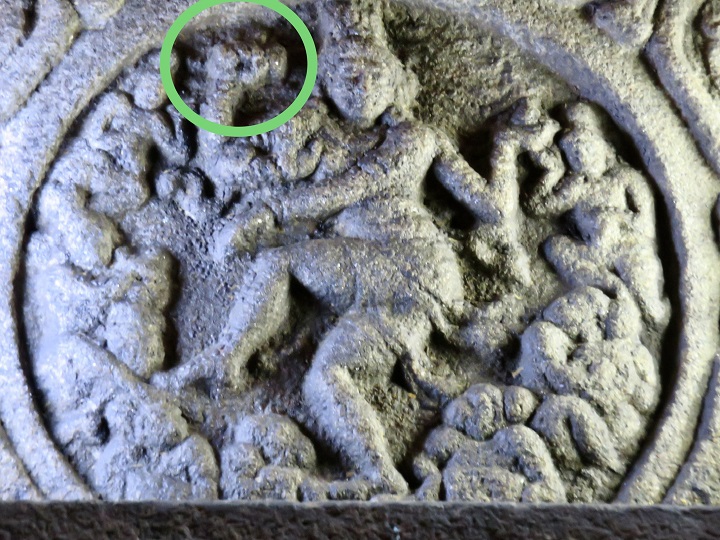 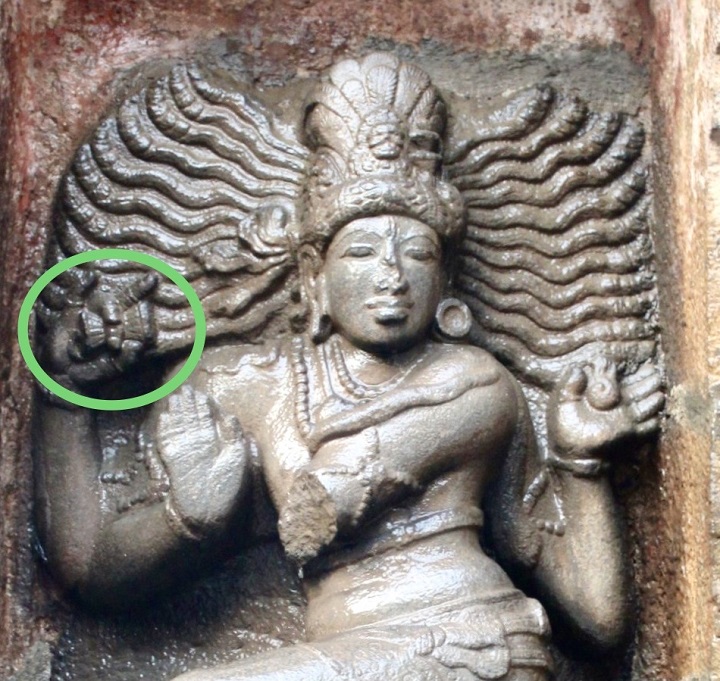 damarugam in thiruerumbiyur temple (early chola miniature) and Chembian Madevi's karunthittaikudi temple The Cholas under the able Vijayalaya captured the supremacy of Tamilagam from the Pallavas in the 9th century CE and subsequently created the mesmerising sculpture of Adavallan- Shiva performing the Ananda Tandava. The miniature sculptures of Adavallan during the early years of Chola rule and the massive Dancing Shiva (in stone and bronze), in the temples built and renovated by Chembian Madevi possess the damarugam as the special instrument of the Cosmic Dancer. Damarugam continues to be an irreplaceable instrument in the right hand of Nataraja/ Dancing Shiva till today. Udukkai 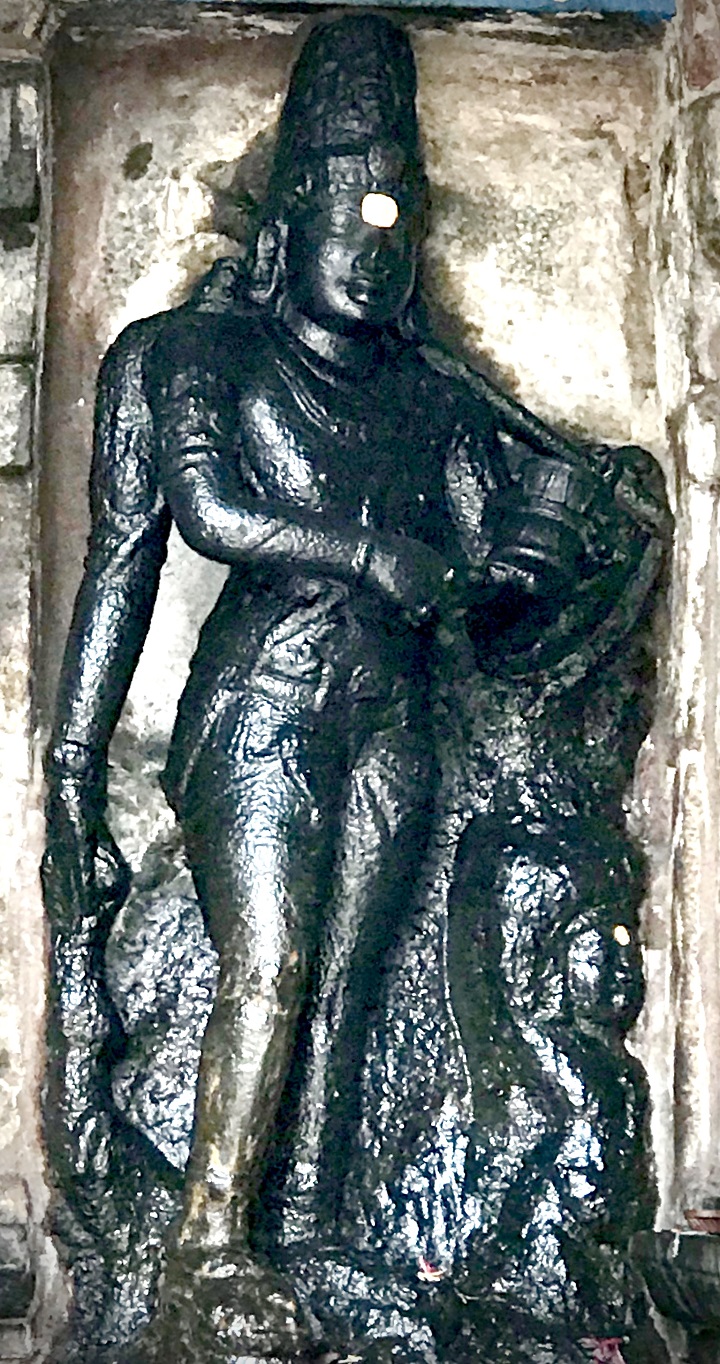 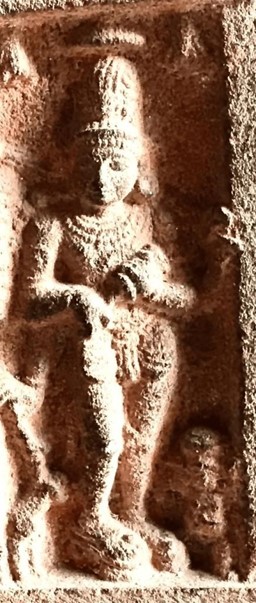 udukkai in the hands of kangaalar, thiruvalanchuli and darasuram Udukkai as a skin head percussion is introduced by Sambandar in his Thiruppathigam on Kaviripoompattinathu Pallavaneecharam (1:65:10). Dr. Kalaikkovan, in his elaborate article refers to Pingala Nigandu (Lexicon) specifiying 'thudiye udukkai (Udukkai is nothing but Thudi)', and suggests "Thudi, which was in extensive use during Sangam age could have been called as Udukkai with time". Another proof that further authenticates such a reasoning is the Udukkai continuing as the instrument of Mariamman – one of the folk/regional forms of Kottravai. It is to be noted again, that the chief goddess of Paalai/ desert land scape was Kottravai and Thudi belonged to Paalai. Like Thudi, Udukkai has an hour glass structure, both faces covered with animal skin, holes on either plates that are connected by long zigzag ropes and a separate rope is tied around the narrow neck. Different rhythms are created by pulling the connecting ropes with the left hand and one face is struck to create musical sound. Sangam and Post sangam texts amplified Thudi as the entranced common man's multi purpose musical drum- be it theft, reclaiming lost property, hunting, post hunting relaxation or celebrating the fresh monsoonal waters. Bhakthi Literature also hails thudi. In comparison, udukkai, as an extension of the ancient thudi, becomes suddenly very much prominent in the medieval Chola inscriptions, while there are no inscriptions that talk of thudi. Inscriptional details on udukkai from the article, through which Dr. R. Kalaikkovan showcases the elevated position of Udukkai during thirupathigam recitals and dance performances- 1. Thiruvidaimaruthur inscription of Paranthaka Chola I's (27th regnal year) mentions of land provided to the artist who played udukkai on all the three worship schedules of the day, in front of presiding deity, 2. Similar provision of land for the udukkai artist continued for almost 300 years till the reign of Kulothunga III's 12th regnal year 3. Thiruverumbiyur inscription of Kandaraditha Chola (3rd regnal year) says there were 4 persons who sang the Thiruppathigams accompanied by udukkai and other rhythmic instruments 4. Thanjavur Rajarajeeshwaram inscription states, while the 48 pidarars sang the thirupathigams infront of the deity, one person named suryadeva kirmavithananaana aalaalavidanga udukkai vichaadhiranaana somasivan played the udukkai 5. Thanjavur thalicheri inscription of Rajaraja I refers to Veerachozhan vidanganaana Rajaraja Srihasthan and Koothan Aadhithanaana Rajaraja Sahasrabahu as udukkai artists among the several musicians who played for the 400 dancers 6. During the reign of Rajaraja I, when the 32 thalicheri dancers performed on festive days in Dhadhapuram Kunthavai Vinnagaram, padaviyam and udukkai were played. This extensive significance of Udukkai in Chola inscriptions could be a prolongation of its usage, complimenting the recital of thevaram hymns through Pallava period. Sculptures of ganas in early Pandya Vettuvan Kovil in Kazhugumalai (8th century CE) is proof of the widespread usage of Udukkai in pallava, pandya and chola society throughout Tamilnadu. Not only for pathigams, the extent of importance given to Udukkai as an accompaniment to dance can also be seen in Chola sculptures. Associated with the worship of Shiva and the dance of Shiva, Chola craftsmen make the Lord of Dance Himself play the 'Udukkai' in a few other of his personifications such as Kangaalar and Urthuva Thandavar. Another exclusive aspect of Udukkai in the hands of Shiva is the rope tied around the narrow waist of the instrument, is a snake for the rugged dancer of the graveyard. Udukkai in the sculptures of Tamilnadu In the hands of ganas 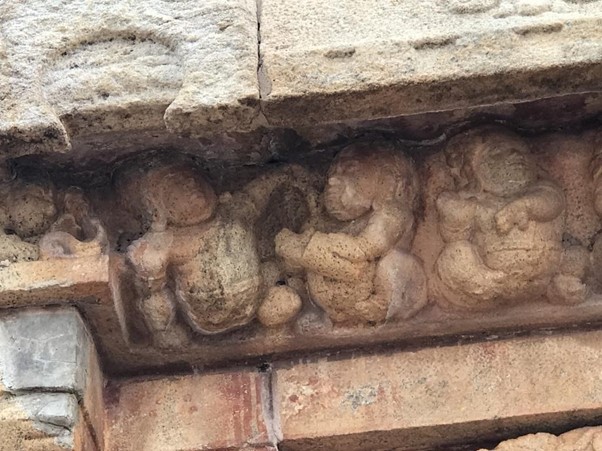 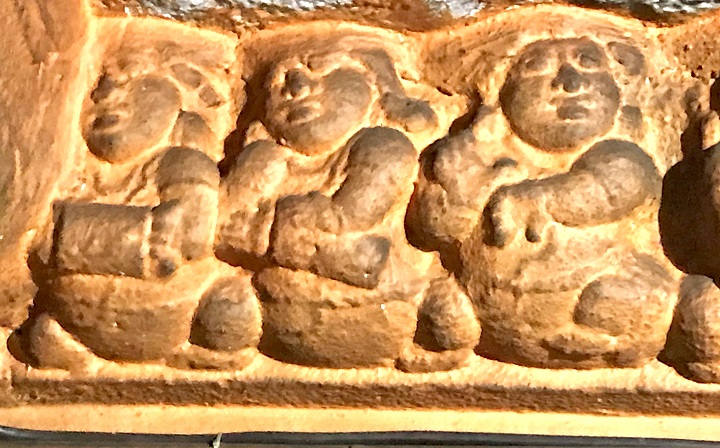 above: vijayalaya choleeswaram and thirunallam 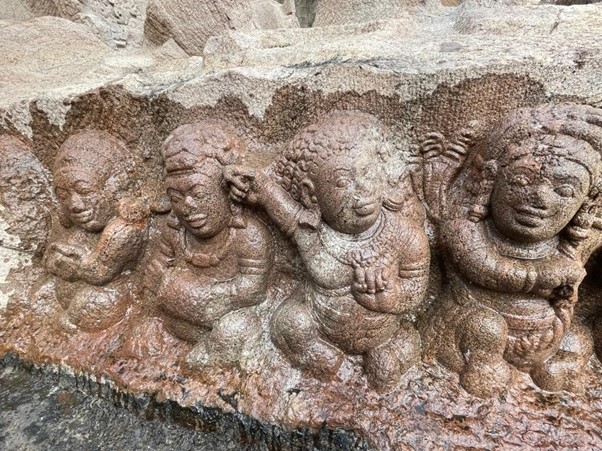 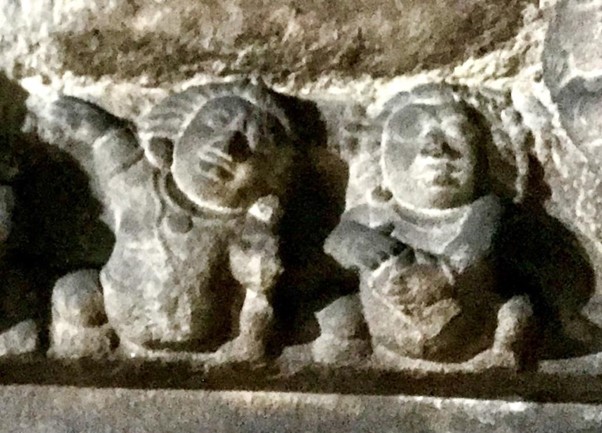 above: kazhugumalai and pullamangai in the hands of artists 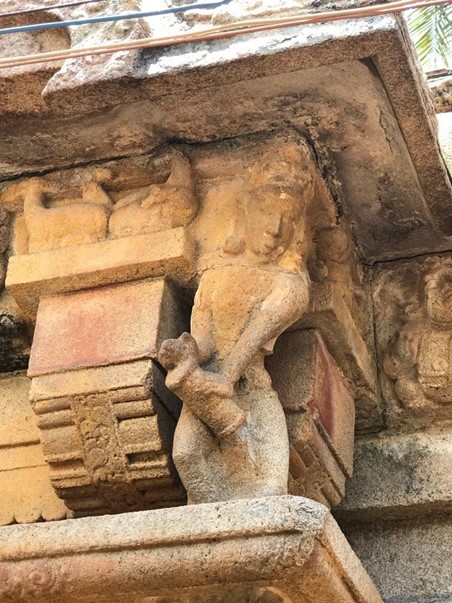 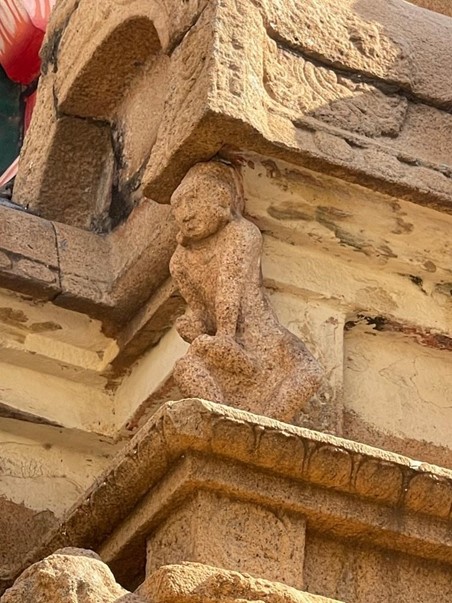 above: pullamangai and kumbakonam nageswarar Such an extensive analysis on thudi, damarugam and udukkai by Dr. R. Kalaikkovan has not only helped me understand the usage and importance of the instruments in the fields of music and dance of ancient and medieval Tamilnadu, but also to differentiate between a few other gadgets, similar and otherwise. The facts translated and discussed above was in a way to retrospect my comprehension on the subject. With this awareness on five similar yet intricately distinct percussion instruments of the Tamils, the task is to identify Thimilai and Idakkai, from the countless sculptures in the spectacular temples of the Great Cholas. Reference books/links- 1. டாக்டர் இரா. கலைக்கோவன், சோழர் கால ஆடற்கலை 2. டாக்டர் இரா. கலைக்கோவன், துடி, தமருகம், உடுக்கை– http://www.வரலாறு.காம்/http://www.varalaaru.com 3. Karaikkal Ammaiyar, Thiruvaalangaattu Mootha Thirupathigam, (kongai thirangi 9) 4. Karuvur Thevar's Thiruvisaippa, 9th Thirumurai, (9.14.3) 5. Thirugnanasambandhar, Kaviripoompattinathu Pallavaneecharam (1:65:10) |

சிறப்பிதழ்கள் Special Issues 

புகைப்படத் தொகுப்பு Photo Gallery 
|
| (C) 2004, varalaaru.com. All articles are copyrighted to respective authors. Unauthorized reproduction of any article, image or audio/video contents published here, without the prior approval of the authors or varalaaru.com are strictly prohibited. | ||